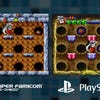Cooly Skunk: how a lost Super NES game was miraculously recovered via satellite download
And how it compares against the revamped PS1 release.
Cooly Skunk, Punky Skunk - this long forgotten platforming mascot character went by a couple of different names during his short life in late 90s gaming - but as of last week, he's suddenly become a lot more interesting. Originally released on the original PlayStation, it turns out that the same game was initially developed for the Super Famicon. More specifically, it was developed, completed, but never physically released and seemingly lost - until the combination of a freak discovery combined with the efforts of the game preservation community brought this title back from oblivion.
As we move into another awkward cross-gen development period, the recovery of Cooly Skunk demonstrates that while game makers have it tough today, the process was just as challenging in the move from 16-bit to 32-bit platforms. It's possible to compare the eventual PlayStation release with the Super Famicom original, and it's fascinating to see just how close the completed Nintendo original compared to the final PS1 release, while at the same time highlighting some radical differences.
But it's the process of Cooly Skunk's recovery that is borderline mind-blowing. The game was developed by a small Japanese company known as Ukiyotei. Founded in 1991 by Kenshi Naruse - previously of Capcom - Ukiyotei would develop a surprisingly solid stable of games during its 11-year run, including an adaptation of Hook for Super NES, published by Sony Imagesoft. Cooly Skunk began as a project to deliver a platforming mascot for publisher Bullet Proof Software, before being cancelled and rebooted for another publisher - Visit - who aimed to tailor game more towards US audiences. By the time it was completed, 16-bit sales were collapsing and so the decision was made to reboot the game for the PlayStation.
However, the Super Famicom version did get the most limited of limited releases. One year prior to the release of Cooly Skunk, Nintendo and St Giga - a Japanese broadcast satellite provider - released a new peripheral and service known as Satellaview for Super Famicom. This add-on consisted of a modular base, the BS-X cartridge and a memory pack all connected to a satellite network.
Through this service, users could access a wide range of content including games and news, all accessible from a beautiful graphical interface accessed on your Super Famicom. This service saw releases such as a full-on remake of the original Legend of Zelda complete with support for Soundlink - a feature which used the satellite radio technology to send pre-recorded audio through your system. Yes, you read that correctly: voice acting and orchestral music was possible with this system though only at the scheduled time. While it has its limitations, it was basically a very early attempt at an interactive online marketplace with downloadable games.
This is where Cooly Skunk factors into the equation. It briefly appeared as a demo on the service - and it just so happens that during this narrow window, a Satellaview user downloaded the game, saving it to his memory pack. Decades later, that pack was discovered in a Japanese store. It was purchased for over $500 and the community raised the money necessary to release it.
After that, a user going by MasterF0x discovered that the demo limit could be removed and by doing so, the entirety of the game could be played right up through to the end credits. Its acquisition is a remarkable story and if you want to know more, this article is absolutely fascinating. Put simply though, a game thought lost forever was recovered in demo form, with the entire content subsequently unlocked - and thanks to a lot of passionate people, it's now widely available. If you want to learn more about this amazing story, I'd highly recommend giving this Gaming Alexandria article a read.

Not only that, we have a game that was developed and completed on two entirely different console generations - and stacking them up side by side, the similarities and differences are intriguing. The publisher, Visit, insisted on enhancing the game to suit the more advanced PlayStation and it essentially takes the form of a redesigned version of the Super Famicom version. Sprites, background artwork and the level designs themselves were all reworked. The PlayStation has significantly more memory and processing power than the Super NES, allowing for more detailed, unique artwork per stage.
It's at this point where I'd suggest looking at the video embedded above to get a more granular look at how the developer revamped and improved the game from its Super Famicom beginnings to its final PlayStation release - but Cooly Skunk hardly made an impact when it launched on Sony's trailblazing console. Platforming titles were making their own initially awkward transition from 2D to 3D and Cooly Skunk didn't catch the imagination of PlayStation users.
That's a bit of a shame as in retrospect, it not only holds up brilliantly but it offers a significant upgrade over what was possible on 16-bit machines. It's not just about the visuals.The levels are expanded beyond the original game or any other game Ukiyotei produced on Super Famicom. There is more room to explore and stages are less reliant on stricter tile placement. It's not an ambitious game, however, and I'm sure it could have worked on a lesser machine, but these elements work together well to create a visually striking and smooth playing game that still looks and plays well today.
What I find so interesting about this situation is that the developers were essentially given the time to refine their creation - a luxury very few game makers get to enjoy. They basically finished the game once and were then presented with an opportunity to completely revamp it for a new platform. While that must have been very frustrating at the time, it's a unique opportunity that produced fascinating results. Either way, the fact that the original, cancelled Super Famicom version exists at all makes this game extremely interesting to me. It's not often that a previously unreleased game is recovered like this - certainly not in a totally complete state. It gives us a lot of insight into what the developer was going through at the time and how the studio when making the transition to what were than next-generation consoles.
The circumstances of Cooly Skunk's retrieval also highlights the unique nature of the Satellaview system for its time period. In a way, this forward-looking technology offered a taste of the future as it used the technology of the time to enable digital delivery, something we take for granted today. What were effectively satellite radio broadcasts also added streaming audio to the mix too - and again, the preservation community has worked to integrate some of these features into the games (in a more interactive form than the originals!).
However, the fact is that while a good amount of Satellaview content is preserved, the Cooly Skunk situation emphasises concerns I've always harboured about the nature of digital marketplaces. Without physical cartridges or discs, preservation can be challenging when games can be delisted at will, or servers (and indeed satellites) decomissioned. For me, this highlights the dangers of a purely digital marketplace - if not for the memory pack on which Cooly Skunk was saved, it may never have been found at all.
But on the flip side, there's something else to consider: Cooly Skunk simply couldn't make a viable business case for release on any kind of physical media. As unlikely and extraordinary a story as its recover is, were it not for Satellaview and this very early form of digital delivery, we may never have seen the game at all.






